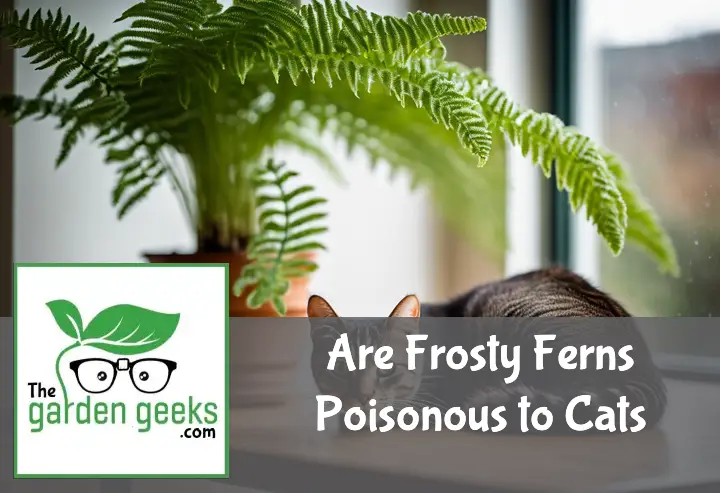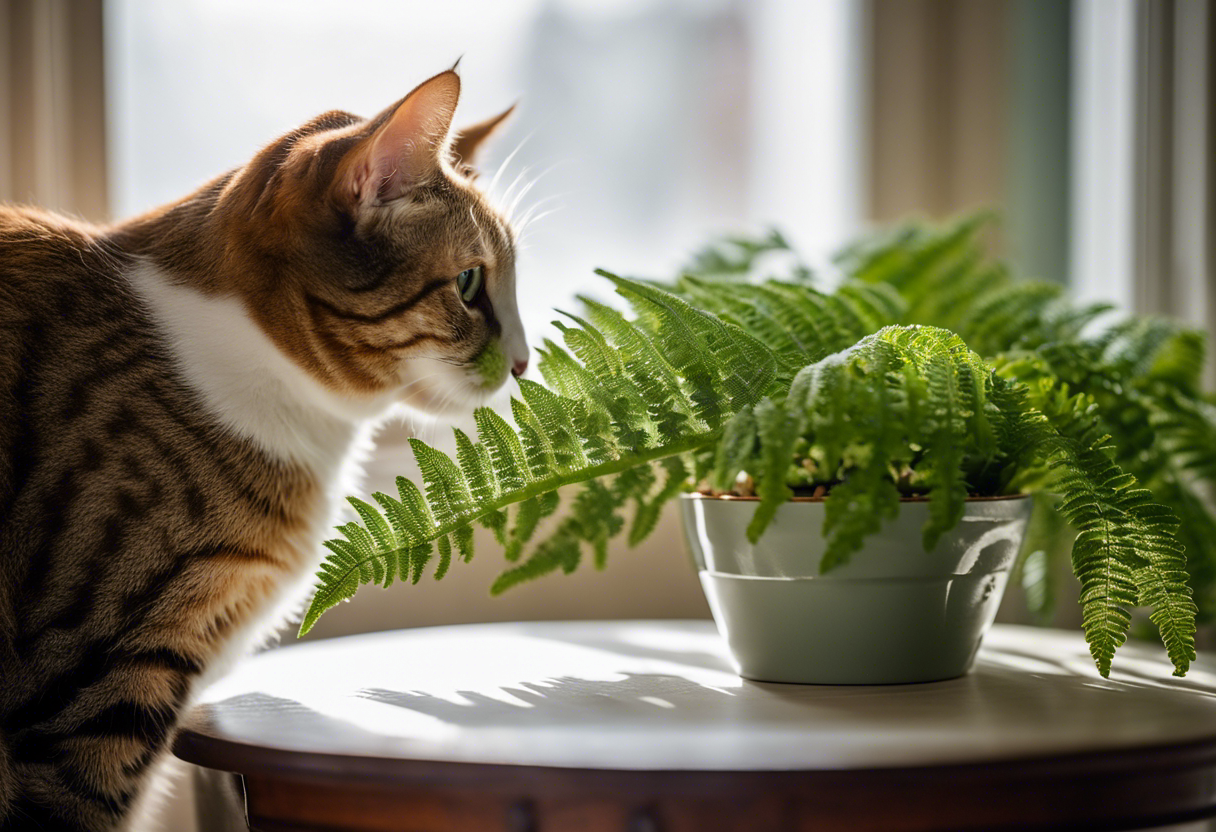Hey there, fellow cat parents! Ever caught yourself wondering, Are Frosty Ferns Poisonous to Cats? Well, you’re not alone. It’s a question that pops up when we’re adorning our homes with these beautiful plants, especially during the winter season.
In this blog post, we’ll delve into the world of frosty ferns and their potential impact on our feline friends. So sit tight and keep reading about ‘Are Frosty Ferns Poisonous to Cats?’ You might discover some surprising facts!
Key Takeaways
- Frosty ferns are not toxic to cats.
- Despite this, ingestion can still cause mild gastrointestinal upset in some cats.
- Symptoms may include vomiting, diarrhea, or loss of appetite.
- If your cat has ingested a frosty fern and is showing these symptoms, it’s recommended to consult with a vet.
- Prevention is key; keep frosty ferns out of reach if your cat tends to chew on plants.
What are Frosty Ferns?
Frosty Ferns, scientifically known as Selaginella kraussiana, are a type of houseplant. They’re unique because they have a frost-like appearance that makes them look like they’ve been dusted with snow. This gives them their cool name and makes them a favorite decorative plant.
Origin and Characteristics of Frosty Ferns
The Origin of Frosty Ferns can be traced back to subtropical regions, but these plants have managed to charm plant lovers worldwide. Their key characteristic is the frost-like foliage that gives them their name.
Their growth habit is also interesting. Unlike your typical fern, Frosty Ferns spread outwards rather than upwards, creating a cascading effect that’s perfect for hanging baskets or as ground cover in terrariums.
Common Uses of Frosty Ferns
When it comes to the Uses of Frosty Ferns, they’re quite versatile. As indoor plants, they add a touch of winter magic to any room without the chill.
They’re also popular as terrarium plants due to their low-growing nature and love for humid environments. And let’s not forget about holiday decorations! With their frost-like appearance, they make excellent festive decor during the winter season. So next time you’re thinking about sprucing up your space, consider adding a Frosty Fern for that extra sparkle!
Are Frosty Ferns Poisonous to Cats?
When it comes to cat safety, the question of whether frosty ferns are poisonous plants is a hot topic. It’s essential for every feline owner to know what their furry friends can and cannot interact with. So, let’s dive into this matter.
Understanding Cat’s Reaction to Frosty Ferns
Now, if you’ve ever seen your cat around a frosty fern, you might have noticed some peculiar behavior. Some cats may show signs of discomfort or illness after coming into contact with these plants. This could range from mild irritation to more severe symptoms like vomiting or diarrhea.
The severity of the reaction often depends on how much of the frosty fern the cat has ingested. In some cases, even just nibbling on the leaves can lead to an adverse reaction. However, remember that each cat is unique and reactions can vary widely.
Scientific Evidence on Frosty Fern Toxicity to Cats
On the scientific front, there isn’t a wealth of research specifically about frosty fern toxicity in cats. But don’t let that fool you into thinking they’re safe! Many experts in feline health caution against allowing cats access to potentially toxic plants.
According to some studies, certain types of ferns contain compounds that can be harmful if ingested by pets. While not all ferns are dangerous, it’s always better to err on the side of caution when it comes to your pet’s health.
In conclusion, while we don’t have definitive proof that frosty ferns are toxic to cats, it’s clear they can cause adverse reactions in our feline friends. Therefore, it’s best practice for cat owners to keep these plants out of reach.
How Does Poisoning Occur in Cats?
Poisoning in our feline friends is often a result of their natural curiosity and grooming habits. When it comes to plant poisoning in cats, ingestion is the main culprit. Now, you might be wondering, “How does my cat end up eating plants?” Well, let’s dive into that.
The Process of Ingestion in Cats
Cats are curious creatures by nature. They love exploring their surroundings and unfortunately, this can lead to them nibbling on plants. This is how cats eating plants becomes a problem. If the plant happens to be toxic, it can cause cat poisoning.
But wait, there’s more! Cats also ingest toxins during their grooming sessions. You see, when they’re out exploring and brushing against various things (including potentially harmful plants), these toxins can get stuck on their fur. Later on, while grooming themselves, they end up ingesting these toxins leading to ingestion poisoning in cats.
Symptoms of Plant Poisoning in Cats
If your cat has been poisoned by a plant, there are certain signs you need to look out for. Physical symptoms may include vomiting, diarrhea or excessive salivation. These are some common physical symptoms in poisoned cats that should raise immediate concern.
Behavioral changes can also indicate something’s off with your kitty. If they’re lethargic or seem unusually anxious or agitated, it could be a sign of plant poisoning. Remember folks – if you suspect your cat has been poisoned, don’t hesitate to seek emergency care for them!
So now we know how cats get poisoned and what symptoms to watch out for but what about Frosty Ferns? Are Frosty Ferns Poisonous to Cats? Stay tuned as we delve into this topic next!
What to Do if Your Cat Ingests a Frosty Fern?
Oh no, your feline friend just had a nibble on that frosty fern! Are Frosty Ferns Poisonous to Cats? Yes, they are. But don’t panic just yet, we’ve got some steps for you to follow.
Immediate Steps to Take
First things first, remove any remaining plant material from your cat’s mouth. That’s right, get in there and scoop it out. This will prevent further ingestion of the frosty fern.
Next up is observation time. Keep an eye on your furball for any signs of distress or unusual behavior. This could be anything from excessive drooling to vomiting or diarrhea. These symptoms indicate cat swallowed plant and it’s causing discomfort.
Lastly, make sure your cat has access to plenty of fresh water. Hydration can help dilute any toxins ingested and promote their elimination through urination.
When to Contact a Veterinarian
Now let’s talk about when it’s time to ring up the vet. If your cat shows severe symptoms like loss of appetite, lethargy or difficulty breathing after eating a frosty fern, it’s definitely time for professional help.
Don’t hesitate if you notice these signs of plant toxicity in cats. Remember, early intervention can make all the difference in cases of potential cat poisoning.
In conclusion, while frosty ferns may add a touch of winter magic to our homes, they’re not so magical for our feline friends. So keep them out of paw’s reach!
Prevention Measures for Cat Owners
When it comes to cat safety, prevention is better than cure. Especially when we’re talking about whether Frosty Ferns are poisonous to cats or not. It’s all about finding safe alternatives and keeping our feline friends away from harmful plants.
Safe Alternatives to Frosty Ferns for Cat Owners
Now, you might be thinking, “What can I replace my frosty fern with?” Well, there are plenty of safe plants for cats out there. For instance, you’ve got your Boston ferns and spider plants. They’re non-toxic and pretty easy on the eyes too!
But wait, there’s more! If you’re into something a bit more exotic, how about a parlor palm? They’re pet-friendly houseplants that won’t harm your furry friend. And let’s not forget about the good old Areca Palm – another great Frosty Fern substitute.
Tips for Keeping Cats Away from Harmful Plants
Alright, so we’ve covered the safe alternatives. But how do we keep our curious kitties away from the no-go zones? Here’s where some solid prevention measures come into play.
Firstly, consider placing your plants in high places where your cat can’t reach them. Cats may be agile climbers but they sure aren’t fans of slippery surfaces or unstable platforms.
Secondly, try using natural deterrents like citrus peels or coffee grounds around your plants. Most cats dislike these smells and will steer clear of them. These are just a few handy harmful plant avoidance tips to help keep your kitty safe and sound!
To Wrap Up
In the cat world, Frosty Ferns are like that tempting box of chocolates you know you shouldn’t nibble on. So, to answer the question, Are Frosty Ferns Poisonous to Cats? Yes, they are!
Keep your feline friend safe by keeping these green temptations out of reach. Remember, curiosity didn’t just kill the cat; it also gave them a nasty bellyache!



